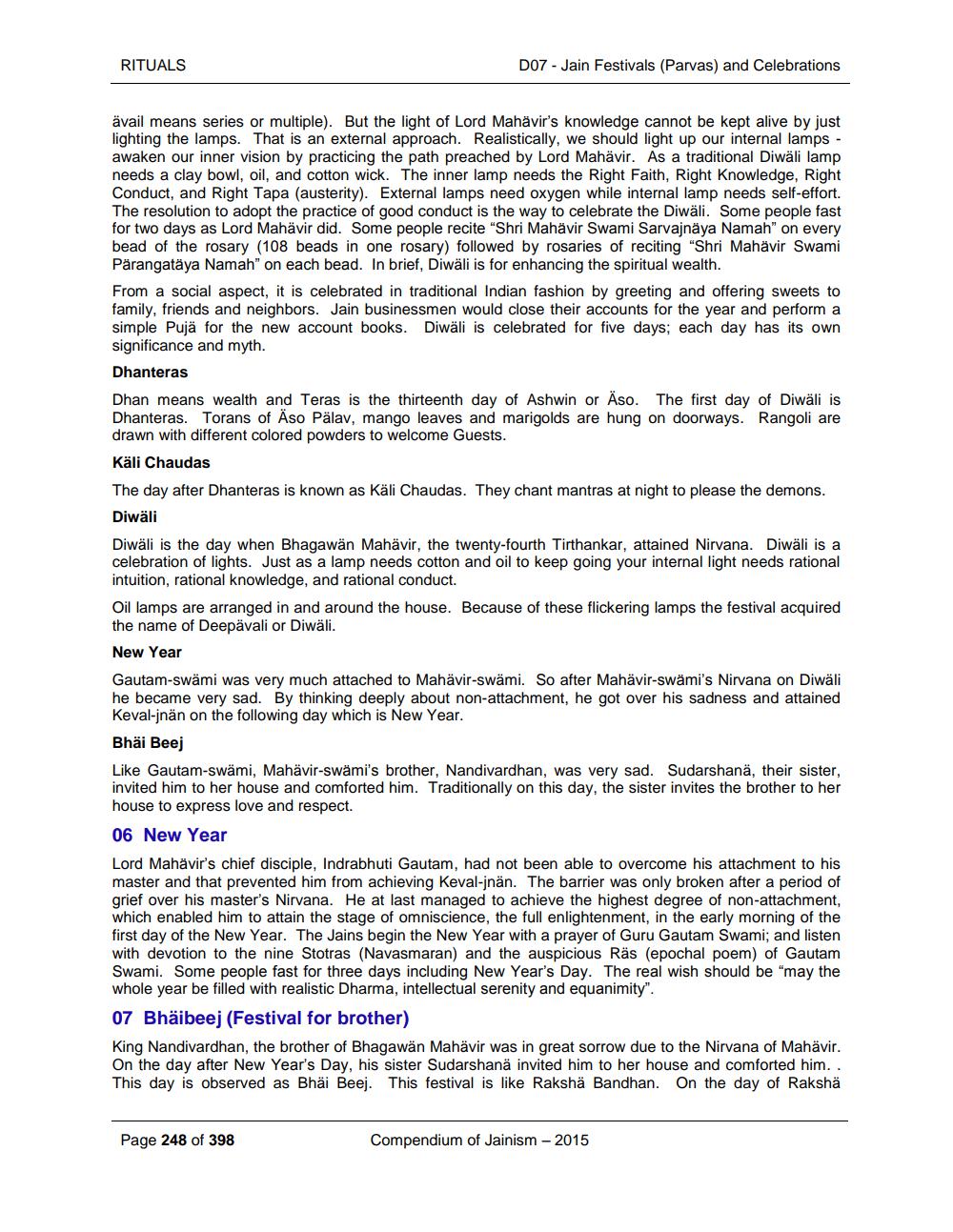________________
RITUALS
DO7 - Jain Festivals (Parvas) and Celebrations
ävail means series or multiple). But the light of Lord Mahävir's knowledge cannot be kept alive by just lighting the lamps. That is an external approach. Realistically, we should light up our internal lamps - awaken our inner vision by practicing the path preached by Lord Mahävir. As a traditional Diwali lamp needs a clay bowl, oil, and cotton wick. The inner lamp needs the Right Faith, Right Knowledge, Right Conduct, and Right Tapa (austerity). External lamps need oxygen while internal lamp needs self-effort. The resolution to adopt the practice of good conduct is the way to celebrate the Diwali. Some people fast for two days as Lord Mahävir did. Some people recite "Shri Mahävir Swami Sarvajnäya Namah" on every bead of the rosary (108 beads in one rosary) followed by rosaries of reciting "Shri Mahävir Swami Pärangatäya Namah" on each bead. In brief, Diwali is for enhancing the spiritual wealth. From a social aspect, it is celebrated in traditional Indian fashion by greeting and offering sweets to family, friends and neighbors. Jain businessmen would close their accounts for the year and perform a simple Puja for the new account books. Diwali is celebrated for five days; each day has its own significance and myth. Dhanteras Dhan means wealth and Teras is the thirteenth day of Ashwin or Aso. The first day of Diwali is Dhanteras. Torans of Aso Pälav, mango leaves and marigolds are hung on doorways. Rangoli are drawn with different colored powders to welcome Guests. Käli Chaudas The day after Dhanteras is known as Käli Chaudas. They chant mantras at night to please the demons. Diwali Diwali is the day when Bhagawan Mahävir, the twenty-fourth Tirthankar, attained Nirvana. Diwali is a celebration of lights. Just as a lamp needs cotton and oil to keep going your internal light needs rational intuition, rational knowledge, and rational conduct. Oil lamps are arranged in and around the house. Because of these flickering lamps the festival acquired the name of Deepävali or Diwali. New Year Gautam-swami was very much attached to Mahävir-swämi. So after Mahävir-swämi's Nirvana on Diwali he became very sad. By thinking deeply about non-attachment, he got over his sadness and attained Keval-jnän on the following day which is New Year. Bhäi Beej Like Gautam-swämi, Mahävir-swämi's brother, Nandivardhan, was very sad. Sudarshana, their sister, invited him to her house and comforted him. Traditionally on this day, the sister invites the brother to her house to express love and respect. 06 New Year Lord Mahävir's chief disciple, Indrabhuti Gautam, had not been able to overcome his attachment to his master and that prevented him from achieving Keval-jnän. The barrier was only broken after a period of grief over his master's Nirvana. He at last managed to achieve the highest degree of non-attachment, which enabled him to attain the stage of omniscience, the full enlightenment, in the early morning of the first day of the New Year. The Jains begin the New Year with a prayer of Guru Gautam Swami; and listen with devotion to the nine Stotras (Navasmaran) and the auspicious Räs (epochal poem) of Gautam Swami. Some people fast for three days including New Year's Day. The real wish should be "may the whole year be filled with realistic Dharma, intellectual serenity and equanimity". 07 Bhäibeej (Festival for brother) King Nandivardhan, the brother of Bhagawan Mahävir was in great sorrow due to the Nirvana of Mahävir. On the day after New Year's Day, his sister Sudarshanä invited him to her house and comforted him.. This day is observed as Bhai Beej. This festival is like Raksha Bandhan. On the day of Rakshä
Page 248 of 398
Compendium of Jainism - 2015




